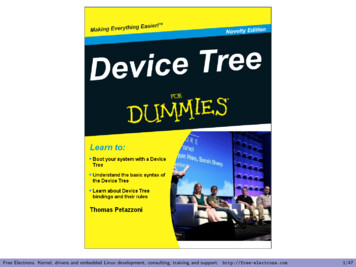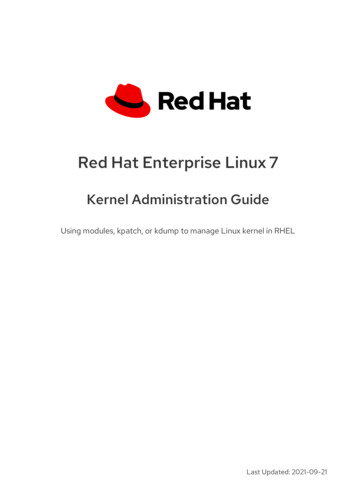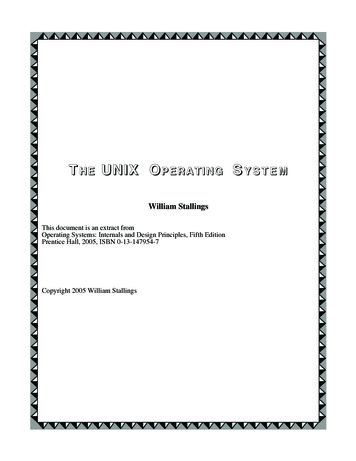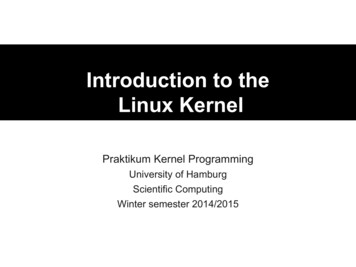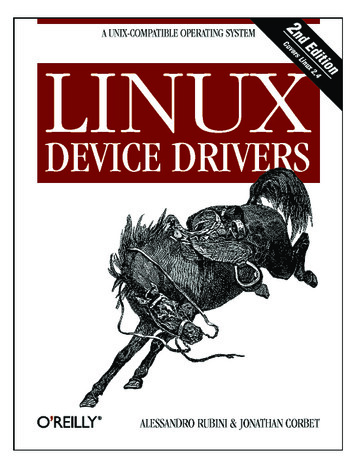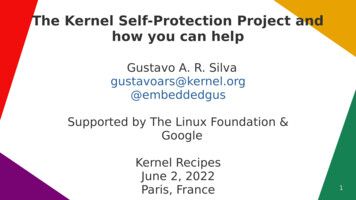
Transcription
The Kernel Self-Protection Project andhow you can helpGustavo A. R. Silvagustavoars@kernel.org@embeddedgusSupported by The Linux Foundation &GoogleKernel RecipesJune 2, 2022Paris, France1
Who am I? Embedded Systems. RTOS & Embedded Linux. Upstream first – 6 years. Kernel developer & maintainer. GOSST - Linux kernel division. Volunteer at @kidsoncomputers
Who am I? Embedded Systems. RTOS & Embedded Linux. Upstream first – 6 years. Kernel developer & maintainer. GOSST - Linux kernel division. Volunteer at @kidsoncomputers“Tuxote”
Agenda The Kernel Self-Protection Project Work in progress and some accomplishments. How you can help. :) Conclusions.
The Kernel Self-Protection Project
The Kernel Self-Protection Project It’s an upstream project. Not a random downstream clone ofLinux.Focused on hardening the upstream Linux kernel.We want to eliminate entire bug classes and methods ofexploitation.Developing of defense mechanisms that cut off whole classesof vulnerabilities. Best way to approach the problem of security. Moving the codebase to use safer APIs. Not about writing CVEs.
Tools and Platforms
linux-hardening Upstream mailing list. Created in 2020.Needed a list to discuss development, maintenance and allthings related.Old list (kernel-hardening) only wanted new stuff.A place to discuss about all the small details and middle stepsin the process of hardening the kernel was needed. linux-hardening@vger.kernel.org 07.946FBE7B@keescook/
Patchwork Keep track of tags: Reviewed-by, Tested-by, Acked-by, etc. The KSPP is not a subsystem, but it has maintainers. :P Sometimes work gets stuck and patches are not applied -for anumber of reasons. Patches are sometimes ignored. Don’t want to miss patches from occasional contributors. Helpful to follow up on all patches sent to the linux-hardeninglist, so we can carry them on our -next trees when hardening/
Issue tracker Issues show up while addressing other issues. Sound familiar? :) Sometimes we need to document stuff before it’s included inthe official documentation. We have good first issues. :) https://github.com/KSPP/linux/issues
“I pulled and then immediately unpulled again.”–Linus Torvalds.
"There is never too much information you can put in a mergecommit. Put what you ate on breakfast. Put everything inthere."–David Miller. #netconf2019
Linus doesn’t care what you had for breakfast. :/
Linus doesn’t care what you had for breakfast. :/ But Dave does. Thanks Dave. :)
Coverity Not actually for kernel hardening, but it’s a good tool for newpeople. Public. Should be named linux-next-daily-scan. Daily scans for linux-next. Kees runs daily builds on his beefy machine. Good place to start for newcomers. Send a request foraccess. ekly-scan/
Coccinelle We use it frequently. Not a magical solution for all we need to fix or change. Code still should be audited. :) https://coccinelle.gitlabpages.inria.fr/website/
Coccinelle 8fe42a12f44b91e5f62
Coccinelle Potential struct size() transformations. All should beaudited.
Kernel Test Robot Build-tests for multiple archs and configurations. GCC andClang. Results usually within 24 hours. Need to ask for your tree to be added to their test suite. Private and public reports. Depending on your preferences. Our test reports are publicly available on LKML. For complex changes I usually include a Build-tested-by tagwith a link to the results.Kernel Test Robot lkp@intel.com
Kernel Test Robot https://lore.kernel.org/lkml/627f92ef.upN0G bCpHComWxr%25lkp@intel.com/
IRC channels and wiki Wanna hang out? :) #linux-hardening #clangbuiltlinux Libera.Chat https://kernsec.org/wiki/index.php/Kernel Self Protection Project
What does it take to harden the kernel?
What does it take to harden the kernel? Sweat and blood!
What does it take to harden the kernel? Sweat and blood! Really!
What does it take to harden the kernel? KSPP is about hardening the Linux kernel. The goals are big. It’s usually not as glamorous as people would think. Auditing code is exhausting and time consuming. We need to develop some strategies. Make the compiler an ally.
What does it take to harden the kernel? Enabling compiler options is an important step forward. Provide the compiler with enough context. Detect as many problems as possible at build-time. Enabling compiler options is not that straightforward. Upstream has its implications. Who would’ve thought? :p Need to solve both technical and political problems.
What does it take to harden the kernel? Political issues tend to delay the work. Some people really dislike some changes. We need to convince people. People have different opinions about security changes acrossthe whole kernel tree.Fortunately, some people really support the project.
What does it take to harden the kernel? A lot of middle steps need to land in order to completeimportant work.Clean ups and mechanical changes.Some are easy to implement, but hard to have them appliedupstream.Maintainers usually don’t like a mechanical change happenexternal to their tree.Avoid friction.
Enabling compiler options
Enabling compiler options Why is it a complex task? Usually tons of warnings. :) “The noisy thing.” Some actual bugs, some false positives. Both are worth resolving. Some of those warnings lead us to find corner cases in bothkernel code and the compiler.
Enabling compiler options Maybe we need to change the narrative a little bit.Small (although not simple) task are usually seen as noisy andcode churn.Accomplishing important things require to pay attention tosmall details, first.The 99-1 rule. 99% perspiration/frustration, 1%inspiration/innovation.Improving the quality and maintainability of the code allowsfor trying to implement more complex stuff.
Work in progress and someaccomplishments struct group() Flexible array transformations. -Warray-bounds memcpy() hardening and the compound effect.
struct group() Wrap a set of declarations in a mirrored struct.Group adjacent members in a struct to be accessed together.Usually through memcpy() or memset().Update to FORTIFY SOURCE caused some memcpy() andmemset() warnings when accessing multiple adjacent membersof a structure at once.The flexibility of the C language. ;)
FORTIFY SOURCE Uses the compiler's builtin object size().Determine the available size at a target address based on thecompile-time known structure layout details.Operates in two modes:–Outer bounds: builtin object size(object, 0)–Inner bounds: builtin object size(object, 1)More details: commit f68f2ff91512
builtin object size() memcpy() under CONFIG FORTIFY SOURCE usesbuiltin object size(object, 1)
struct group() Create a mirrored named and anonymous struct. Commit 50d7bd38c3aa
struct group() Group entries and mac into sectors and then do the memset().(commit f069c7ab6cfb)
Before struct group() Addressing some -Warray-bounds warnings beforestruct group() (commit 606636dcbdbb)
Before struct group() Enclosing struct members into new structures upiu req andupiu rsp (commit 1352eec8c0da)
struct group() struct group() struct group attr() struct group tagged() More details in commit 50d7bd38c3aa
Flexible array transformations
Flexible array transformations 0-element was a GNU extension. 1-element was a hack. Flexible array member was introduced in C99. One-element arrays are particularly confusing and prone toerror.zero-element and one-element arrays are t-arrays These transformations are tricky and not that straightforward. Ihave introduced bugs (all fixed already :p) while doing flexiblearray transformations.
zero-length array sizeof(instance- items) 0 (commits ab91c2a89f86,f2cd32a443da)
one-element array We have to remember to calculate n - 1 when using thestruct size() helper.
flexible array member Now, with the hardened memcpy(), we can omit the use offlex array size() in this case.
Flexible arrays and trailing arrays Compilers treat all trailing arrays as flexible arrays.It breaks FORTIFY SOURCE in that any struct with a fixedsize trailing array will receive no sanity checking.It seems that there are a lot of legacy code “taking advantage”of that.-fstrict-flex-array?GCC and Clang bugs:https://gcc.gnu.org/bugzilla/show bug.cgi?id 55741
-Warray-bounds Enabled for GCC 11 and earlier. :) 153 more new warnings with GCC 12 v5.18, GCC 11 to GCC 12: grep warning: fedora36.log grep 'Warray-bounds' wc -l153 https://github.com/KSPP/linux/issues/190
-Warray-bounds It is finding bugs. :) keescook/
Other work -Wstringop-overflow making progress.https://git.kernel.org/linus/a3a8b54b4f1a -Wimplicit-fallhrough for Clang is now enabled. We had almost40,000 warnings.https://github.com/KSPP/linux/issues/115 -Wcast-function-type is now enabled.https://git.kernel.org/linus/01367e86e90
memcpy() hardening and the compoundeffect. https://outflux.net/slides/2022/lca/1
How you can help. :)
How you can help. :) Doing flexible array transformations, of course. :)https://github.com/KSPP/linux/issues/79 Issue 79 contains a list with hundreds of patches that havelanded in mainline. They can be used as examples.Audit code and use the helpers available, when possible:struct size(), struct group(), flex array size(), size add(),size mul(), etc. See commit e1be43d9b5d0Take a look at the issue tracker. We have issues for everybody. :)https://github.com/KSPP/linux/issues/
one-element arrays to flexible arrays Find uses of sizeof on the involved struct-with-one-elementarray or on the type of the one-element array itself.Find the n – 1 pattern and change it to just n. If you don’t findthis pattern then something else may be going on, and youneed to carefully verify that the size for the allocation andthe iteration over the array are correct. Otherwise, chancesare you just found a bug (usually an off-by-one error).Look for any iteration over the array and verify it is still withinthe boundaries. Usually in the form of a for loop. Usediffoscope before/after the changes to check the binary.CC-me: gustavoars@kernel.org
one-element arrays to flexible arrays The ideal scenario. (commit c72a826829cc)
Conclusions
The best outcome In regards to the technical portion of this work, we want toachieve having a robust and hardened kernel with securecore infrastructure and safer APIs, that allow us to botheliminate entire bug classes and methods of exploitation inthe upstream Linux kernel. That definitely would be the bestoutcome.
Political work Hopefully the social and political work we've been doing allthis time will make it easier to introduce more changes thatimprove the security of the kernel and, at the same time,benefit new people that want to collaborate with us by helpingthem navigate with ease the, sometimes, wild waters of theLinux kernel community.
A commit at a time Change in the kernel, especially in terms of security, is anevolutionary process. It is slow and demands a lot ofpatience. There is still more work than we can get done. Wealways welcome people who can help out. Companiesparticipating in any ecosystem that's based on Linux need toreally consider funding projects that improve the overall securityof the kernel. This is an effort that is driving change a commitat a time and, that benefits billions of people around theworld, including of course, users and customers of techcompanies of all x-kernel-security-done-right.html
Thank you! :)Gustavo A. R. Silvagustavoars@kernel.org@embeddedgus
The Kernel Self-Protection Project It's an upstream project.Not a random downstream clone of Linux. Focused on hardening the upstream Linux kernel. We want to eliminate entire bug classes and methods of exploitation. Developing of defense mechanisms that cut off whole classes of vulnerabilities.Best way to approach the problem of security.

